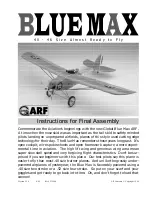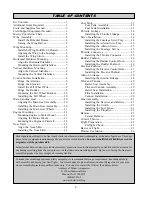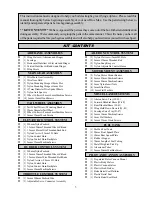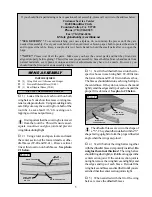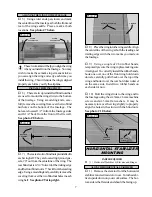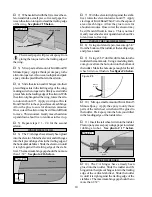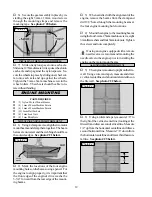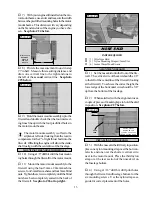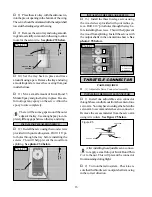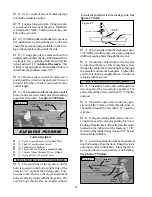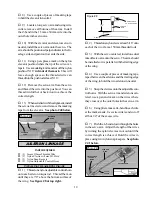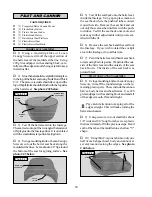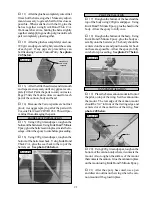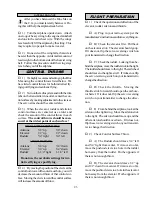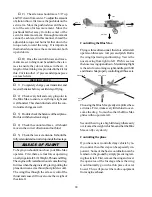
9
Figure # 3
o
8) When you are satisfied that everything is
aligned correctly, mix up a generous amount of
Kwik Bond 30 Minute Epoxy. Apply a thin layer
to the bottom of the stabilizer mounting area and
to the top of the stabilizer mounting platform on
the fuselage. Set the stabilizer in place and re-
align. Double check all of your measurements
once more before the epoxy cures. Hold the sta-
bilizer in place with T-pins or masking tape and
remove any excess epoxy using paper towels and
rubbing alcohol.
PARTS REQUIRED
VERTICAL STABILIZER
MOUNTING
ALIGN THE VERTICAL STABILIZER
o
{1} Vertical Stabilizer w/Rudder and Hinges
o
1) Remove the rudder from the stabilizer.
Slide the stabilizer into the slot in the top of the
horizontal stabilizer. The rear edge of the vertical
stabilizer should be even with the rear edge of the
horizontal stabilizer and fuselage. It should also
be pushed down completely into the slot.
o
2) Using a pen, draw a line on each side of
the vertical stabilizer where it meets the top of the
slot on the horizontal stabilizer.
o
3) Remove the stabilizer. Using a modeling
knife, remove the covering from just below the lines
you drew. Also remove the covering from the bot-
tom edge of the stabilizer. See photo # 14 below.
Photo # 14
When cutting through the covering to re-
move it, cut with only enough pressure to
only cut through the covering itself. Cutting into
the balsa structure may weaken it. There may
also be covering material overlapped on the in-
side edges of the vertical stabilizer mounting slot
in the horizontal stabilizer. Using a modeling knife,
carefully remove this covering also. This will help
insure a good glue joint.
o
4) Set the vertical stabilizer back in place.
Using a triangle, check to ensure that the vertical
stabilizer is aligned 90º to the horizontal stabilizer.
See figure # 3 below.
MOUNTING THE VERTICAL STABILIZER
o
5) When you are satisfied that everything is
aligned correctly, mix up a generous amount of
Kwik Bond 30 Minute Epoxy. Apply a thin layer
to the mounting slot in the top horizontal stabilizer
and to the sides and bottom of the vertical stabi-
lizer mounting area. Set the stabilizer in place
and realign. Double check all of your measure-
ments once more before the epoxy cures. Hold
the stabilizer in place with T-pins or masking tape
and remove any excess epoxy using paper tow-
els and rubbing alcohol. Allow the epoxy to fully
cure before proceeding.
PARTS REQUIRED
CONTROL SURFACE
INSTALLATION
HINGE THE AILERONS
o
{2} Ailerons w/Hinges
o
{1} Elevator w/Hinges
o
{1} Rudder w/Hinges
o
{1} Tail Wheel Wire w/Mounting Bracket
o
{1} 25mm Diameter Tail Wheel
o
{2} Wheel Collars w/3mm x 6mm Machine Screws
o
{3} 3mm x 12mm Wood Screws
o
1) The C/A hinges have already been glued
into the two ailerons. Working with one aileron
at a time, slide the aileron and it's hinges into their
precut hinge slots in the trailing edge of the wing,
making sure the torque rod is firmly seated in the
precut hole in the leading edge of the aileron. Slide
the aileron in until it is tight against the trailing
edge of the wing. The maximum hinge gap should
be no more than 1/32” and the tip of the aileron
should be flush with the tip of the wing.
REMOVE
COVERING
90º

